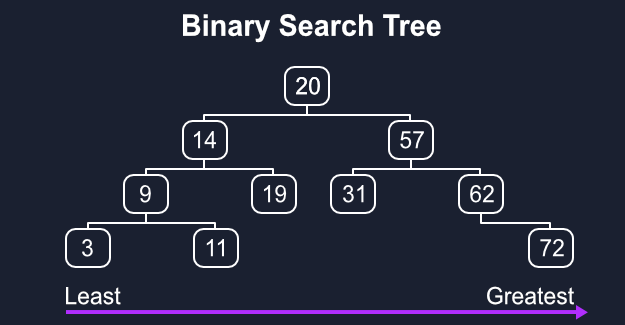 Logicmojo - Updated Sept 18, 2021
Logicmojo - Updated Sept 18, 2021
Within programming, there are many different Data Structures one of which is a tree. Then within that, there are many different types of tree structures. The tree data structure we focused on for this article is the Binary Search Tree.
Binary Search Tree Implementation
# Binary Search Tree operations in Python # Create a node class Node: def __init__(self, key): self.key = key self.left = None self.right = None # Inorder traversal def inorder(root): if root is not None: # Traverse left inorder(root.left) # Traverse root print(str(root.key) + "->", end=' ') # Traverse right inorder(root.right) # Insert a node def insert(node, key): # Return a new node if the tree is empty if node is None: return Node(key) # Traverse to the right place and insert the node if key < node.key: node.left = insert(node.left, key) else: node.right = insert(node.right, key) return node # Find the inorder successor def minValueNode(node): current = node # Find the leftmost leaf while(current.left is not None): current = current.left return current # Deleting a node def deleteNode(root, key): # Return if the tree is empty if root is None: return root # Find the node to be deleted if key < root.key: root.left = deleteNode(root.left, key) elif(key > root.key): root.right = deleteNode(root.right, key) else: # If the node is with only one child or no child if root.left is None: temp = root.right root = None return temp elif root.right is None: temp = root.left root = None return temp # If the node has two children, # place the inorder successor in position of the node to be deleted temp = minValueNode(root.right) root.key = temp.key # Delete the inorder successor root.right = deleteNode(root.right, temp.key) return root root = None root = insert(root, 8) root = insert(root, 3) root = insert(root, 1) root = insert(root, 6) root = insert(root, 7) root = insert(root, 10) root = insert(root, 14) root = insert(root, 4) print("Inorder traversal: ", end=' ') inorder(root) print("\nDelete 10") root = deleteNode(root, 10) print("Inorder traversal: ", end=' ') inorder(root)
Implementation in C++
// Binary Search Tree operations in C++ #include <iostream> using namespace std; struct node { int key; struct node *left, *right; }; // Create a node struct node *newNode(int item) { struct node *temp = (struct node *)malloc(sizeof(struct node)); temp->key = item; temp->left = temp->right = NULL; return temp; } // Inorder Traversal void inorder(struct node *root) { if (root != NULL) { // Traverse left inorder(root->left); // Traverse root cout << root->key << " -> "; // Traverse right inorder(root->right); } } // Insert a node struct node *insert(struct node *node, int key) { // Return a new node if the tree is empty if (node == NULL) return newNode(key); // Traverse to the right place and insert the node if (key < node->key) node->left = insert(node->left, key); else node->right = insert(node->right, key); return node; } // Find the inorder successor struct node *minValueNode(struct node *node) { struct node *current = node; // Find the leftmost leaf while (current && current->left != NULL) current = current->left; return current; } // Deleting a node struct node *deleteNode(struct node *root, int key) { // Return if the tree is empty if (root == NULL) return root; // Find the node to be deleted if (key < root->key) root->left = deleteNode(root->left, key); else if (key > root->key) root->right = deleteNode(root->right, key); else { // If the node is with only one child or no child if (root->left == NULL) { struct node *temp = root->right; free(root); return temp; } else if (root->right == NULL) { struct node *temp = root->left; free(root); return temp; } // If the node has two children struct node *temp = minValueNode(root->right); // Place the inorder successor in position of the node to be deleted root->key = temp->key; // Delete the inorder successor root->right = deleteNode(root->right, temp->key); } return root; } // Driver code int main() { struct node *root = NULL; root = insert(root, 8); root = insert(root, 3); root = insert(root, 1); root = insert(root, 6); root = insert(root, 7); root = insert(root, 10); root = insert(root, 14); root = insert(root, 4); cout << "Inorder traversal: "; inorder(root); cout << "\nAfter deleting 10\n"; root = deleteNode(root, 10); cout << "Inorder traversal: "; inorder(root); }
Time & Space Complexity Analysis
| Operations | Best Case | Average Case | Worst Case |
|---|---|---|---|
| Search | O(logn) | O(logn) | O(n) |
| Insertion | O(logn) | O(logn) | O(n) |
| Deletion | O(logn) | O(logn) | O(n) |
Here, n is the number of nodes in the tree.
Space Complexity:The space complexity for all the operations is O(n).
With this article at Logicmojo, you must have the complete idea of analyzing Binary Search Tree.
Good Luck & Happy Learning!!
